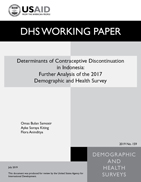
Abstract:
Indonesia is experiencing a great challenge
in achieving replacement-level fertility, a
total fertility rate of 2.1 children per
woman. A persistent level of contraceptive
discontinuation can contribute to this
phenomenon. This study aims to examine the
determinants of contraceptive discontinuation
in Indonesia, using data from the 2017
Indonesia Demographic and Health Survey
(DHS). We use the DHS monthly contraceptive
calendar and the Gompertz proportional
hazards model for analysis. The unit of
analysis is the episode of contraceptive use
during 3-62 months before the survey among
women in union age 15-49. The outcome
variable is the duration of the risk period
up to the occurrence of the contraceptive
discontinuation. The independent variables
include a method-related factor (type of
contraceptive method discontinued),
demographic factors (age, parity, and
contraceptive intent), and socioeconomic and
cultural factors (internet use, mobile phone
ownership, education, work status, place of
residence, household wealth status, and
women’s participation in decision-making).
The results of the study show that almost 3
of every 10 contraceptive use episodes in
Indonesia were discontinued within 12 months
of starting an interval of use.
Discontinuations due to side effects and
health concerns were by far the largest
contributor to the overall discontinuation
rate in Indonesia, with pill episodes showing
the highest 12-month contraceptive
discontinuation rates, followed by injectable
episodes. The study also found that higher
hazard of contraceptive discontinuation were
associated with pill use compared with other
methods, and for women who were older, had
fewer children, spaced births, ever used the
internet, had a mobile phone, had more
education, were currently not employed, lived
in a rural area, were in the lowest and
second household wealth quintile, and did not
participate in decision-making.
The findings from this study reveal important
determinants of contraceptive discontinuation
and present guidance crucial for improving
family planning services in Indonesia in
order to reduce unnecessary and unintentional
contraceptive discontinuation. The higher
contraceptive discontinuation due to side
effects/health problems and for the two most
favored methods, pills and injectables, may
suggest a need for better provider-client
communication and counseling, and
improvements in contraceptive technology.
Similarly, for women in the groups with
higher risk of discontinuation, our findings
suggest a need for more family planning
counseling on contraceptive discontinuation
management.
 Determinants of Contraceptive Discontinuation in Indonesia: Further Analysis of the 2017 Demographic and Health Survey (PDF, 427K)
Determinants of Contraceptive Discontinuation in Indonesia: Further Analysis of the 2017 Demographic and Health Survey (PDF, 427K)
